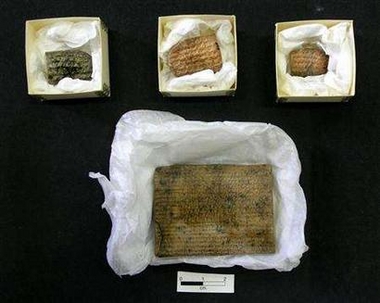Iran said on Wednesday it wanted to use diplomacy and cultural channels to
ensure ancient clay tablets at the center of a compensation case are returned
from the United States but said it was also ready for a legal fight.

Achaemenian clay
tablets written in cuneiform, which had previously been studied at the
University of Chicago, are shown at Iran's National Museum in Tehran, May
2, 2004. Iran said on Wednesday it wanted to use diplomacy and cultural
channels to ensure ancient clay tablets at the center of a compensation
case are returned from the United States but said it was also ready for a
legal fight.[Reuters] |
The 2,500-year-old Persian tablets, which have been studied for decades at
the University of Chicago, give a unique insight into the workings of the
Persian empire with cuneiform etchings of payments and rations made to priests,
guards and workers.
Many tablets in the collection loaned to the university have already been
sent back to Iran but those still under study are at the center of an Israeli
compensation suit connected to a shooting in the West Bank blamed on an
Iranian-backed group.
A U.S. court has ruled that Iran's assets can be seized and last month a U.S.
judge upheld the ruling, prompting a new campaign by Iran to secure the tablets'
return, including an appeal to the U.N. cultural body UNESCO.
"We should first exhaust diplomatic ways, cultural correspondence,
administrative and friendly ways to take all of the property back," said Omid
Ghanami, director of legal affairs at Iran' Cultural Heritage and Tourism
Organization.
He also said Iran could file a suit if the university did not return them and
was taking legal advice, Iran's Fars news agency reported.
The compensation suit was brought by relatives of Yaron Ungar, killed in a
shooting in 1996 near Beit El, a Jewish settlement in the West Bank. Four
members of Palestinian group Hamas, which Iran supports, were convicted by an
Israeli court.
The University of Chicago, which has been working on the tablets since the
1930s, says it opposes the U.S. court ruling.
"The Oriental Institute will do everything in its power to protect cultural
patrimony and the character of the tablets as an irreplaceable scholarly data
set," Gil Stein, director of the university's Oriental Institute, wrote to
Iran's heritage body.
The collection of tablets, roughly the size of a postcard when in one piece,
with broken pieces numbered about 30,000 when found in the 1930s in the ancient
Persian capital of Persepolis.
Many broke further when moved from site or shipped to Chicago where they were
sent on loan for study, said Iranian scholar Shahrokh Razmjou.
The tablets record barley and other payments inside the Persian empire from
509 to 494 B.C., around the height of Persian power at the time of Darius the
Great, he said. Such information is not found on royal texts carved in stone.
The tablets include records of payments between priests and guards of
different religions, a unusual account of such cooperation. Seals also depict
artistic scenes from the period.
Razmjou, who exhibited some previously returned tablets in Iran's national
museum, said it was not important if research continued in Chicago or elsewhere,
even though the tablets belonged to Iran. But he said the artefacts should not
be politicized or turned into a financial resource.
"They are a kind of memory of mankind. They are not a financial source to be
used in courts," he said.
The U.S. District Judge Blanche Manning said Iran could have asserted
immunity for its property during the case but did not.
Although priceless historical pieces, scholars say the tablets would have
limited value in the art market.